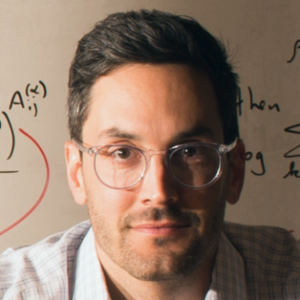
Daniel Larremore
The following Great Innovative Idea is from Daniel Larremore, Assistant Professor at University of Colorado Boulder Computer Science Department and the BioFrontier Institute, where he leads Larremore Lab. In addition, he holds affiliations with the Department of Applied Mathematics and with the Center for Communicable Disease Dynamics at the Harvard T.H. Chan School of Public Health. His recent work with COVID-19 has captured the attention of large media sources such as Medscape, the Washington Examiner and the New York Times.
The Idea
How does the progression of a typical SARS-CoV-2 infection affect the way we should think about COVID-19 policies, like testing and vaccine prioritization? When doing mathematical and computational modeling in epidemiology, it is natural to reach for the standard Susceptible-Exposed-Infected-Recovered (SEIR) model for disease transmission, but this model sweeps important biological details under the rug.
When it comes to testing, for example, by modeling the dynamics of viral growth, peak, and clearance within an individual infection, we’ve found that, perhaps surprisingly, COVID-19 test sensitivity is secondary to test frequency and turnaround time. When it comes to COVID-19 vaccine prioritization, by modeling the infection-, transmission-, and disease-blocking effects of current vaccines as having distinct effects on disease, we’ve been able to evaluate possible vaccine prioritization scenarios for countries around the world while incorporating the current known and unknown impacts of today’s vaccines.
Impact
We often think about testing as a question, either from the individual’s perspective—am I infected?—or from a public health perspective—how many new cases were there yesterday? However, our work has shown that testing can also be an answer by giving people the information they need to isolate and protect those around them. Critically, we’ve shown that when it comes to a fast-moving virus like SARS-CoV-2, getting information with low latency is more important than getting perfect information. This has led to the use of fast, frequent, and low-cost testing to be rolled out at scale to break transmission chains through population screening.
Vaccine prioritization, on the other hand, is difficult because it is easy to reason about using “common sense”: it makes sense to use the vaccine to protect the vulnerable. But, it also makes sense to use the vaccine to break down transmission and protect everyone. When common-sense approaches lead to opposing conclusions, that’s a good indicator that common sense isn’t a good way to make decisions. Instead, our modeling work has shown that for the rates of viral spread, and the pace of vaccine rollout worldwide, that after front-line healthcare workers, early doses should be prioritized to older adults who are more vulnerable if the goal is to minimize mortality and years of life lost.
Other Research
My group focuses on developing methods of networks, dynamical systems, and statistical inference, to solve problems in biological and social systems. We have one foot in CU Boulder’s BioFrontiers Institute and the other foot in the Department of Computer Science, and so we try to keep a tight loop between data and theory, and learn a lot from confronting models and algorithms with real problems.
In biological systems, we focus on the spread and evolution of infectious disease. In spite of shifted focus toward COVID modeling and seroepidemiology to meet the needs of the current moment, we focus on the malaria parasite P. falciparum which evolves rapidly to evade the human immune system. Our goal is to understand the interplay between parasite evolution and human immunity, and its implications for parasite virulence, population structure, and epidemiology. In social systems, we focus on understanding the patterns and processes that define the ecosystem of scientific research and discovery, including analyses of faculty hiring and patterns in publication rates. Our goal is to combine rigorous computation, ecological theory, and social science to understand how the scientific community can be made more equitable and more productive.
Researcher’s Background
After a B.S. in Chemical Engineering from Washington University in St. Louis, and a couple years in industry, I started an M.S. in Applied Mathematics at University of Colorado Boulder, where I got hooked on research on dynamical systems and complex networks, and I went on to finish a PhD in Applied Mathematics at the University of Colorado. I then took a postdoc fellowship at the Center for Communicable Disease Dynamics at the Harvard T. H. Chan School of Public Health, where I worked on network models for malaria parasite epidemiology. After that, I was an Omidyar Fellow at the Santa Fe Institute, where I started thinking about social systems, complex networks, and inference more rigorously, before joining the faculty at the CU Boulder’s Department of Computer Science and BioFrontiers Institute in 2017. My work now basically combines the mathematics, epidemiology, and complex systems from each of these previous stages. One thing I love about CU Boulder’s CS Department and BioFrontiers Institute is that there’s a strong and supportive home for interdisciplinary groups like mine.
Links
My website: https://larremorelab.github.io/
Studies:









